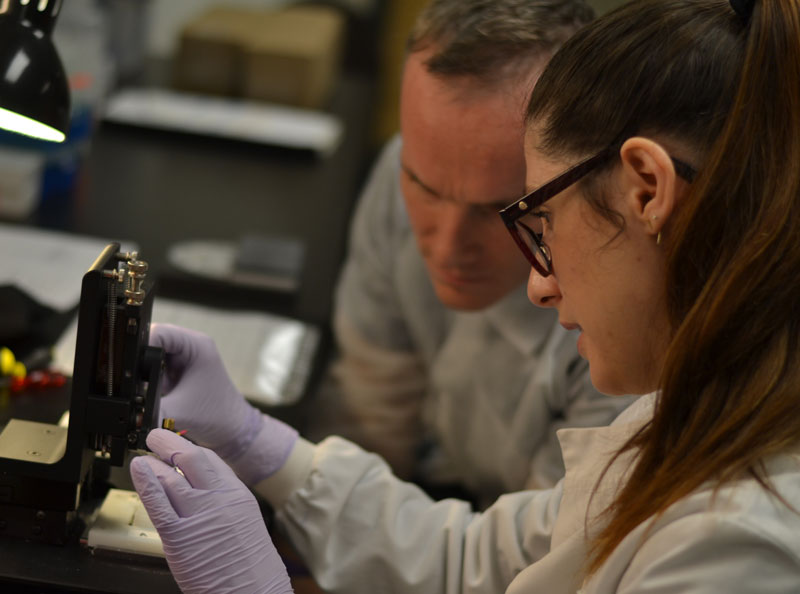Supporting and empowering Ontario’s cancer researchers
Ontario is fortunate to be home to some of the top cancer scientists in the world and a robust research infrastructure. Over the last year, OICR has launched a series of initiatives that look to build upon this solid foundation and further strengthen Ontario’s cancer research sector. To enable more cutting-edge translational cancer research the Institute is establishing new collaborative research networks, supporting multi-disciplinary projects and making advanced technologies and expertise available to researchers.
Building the future of pathology in Ontario
 Pathologists have been called “the doctor you never see.” These doctors who toil away in hospital labs across the province may not have much face time with patients, but they play an essential role in diagnosing cancer. While pathologists can still be found looking into microscopes at slides of tissue samples, they are becoming more involved in genomic testing, part of a quickly growing field called molecular pathology. The results of these tests are used as the basis to provide patients with care tailored to the specifics of their cancer – a concept known as precision medicine.
Pathologists have been called “the doctor you never see.” These doctors who toil away in hospital labs across the province may not have much face time with patients, but they play an essential role in diagnosing cancer. While pathologists can still be found looking into microscopes at slides of tissue samples, they are becoming more involved in genomic testing, part of a quickly growing field called molecular pathology. The results of these tests are used as the basis to provide patients with care tailored to the specifics of their cancer – a concept known as precision medicine.
Pathologists are the bridge that can bring genomics to patients. We think our research will be central to making that a reality - Dr. David LeBrun
In September 2016, OICR launched the Ontario Molecular Pathology Research Network (OMPRN) to increase the province’s capacity for molecular pathology by fostering collaborations, mobilizing more pathologists in translational cancer research and providing more opportunities for training and mentorship in pathology cancer research. This will help Ontario to stay on the cutting edge of cancer diagnosis.
“Pathologists are uniquely positioned to drive the adoption of precision medicine for cancer,” says Dr. David LeBrun, Network Leader of OMPRN. “The question is now how do we support our pathologists to enable the use of new diagnostic techniques that are increasingly important in modern cancer care?” LeBrun is also a Professor of Pathology and Molecular Medicine at Queen’s University in Kingston, Ontario.
OMPRN is involving more pathologists in collaborative, translational cancer research. The projects funded by the Network’s grants are required to be transdisciplinary in nature, involving non-pathologists as research collaborators. Mentorship of pathology trainees or early-career pathologist researchers is also a requirement. OMPRN has engaged with the Royal College of Physicians and Surgeons of Canada to promote the integration of molecular pathology into the curriculum of residency training programs across the country.
“Pathologists don’t need to be geneticists, but they need to have enough knowledge to be conversant in, and use, genomic data,” says LeBrun. “Pathologists are the bridge that can bring genomics to patients. We think our research will be central to making that a reality.”
Opening OICR’s technology and expertise to Ontario researchers
In September 2016, OICR also launched the Collaborative Research Resources (CRR) Directory, which provides cancer researchers outside of OICR with a one stop shop to access the Institute’s expertise and technologies.
OICR has world-class research facilities and investigators that can help to assist other researchers in their work. Opening up these resources to more Ontario scientists is a way to help facilitate research province-wide. “We wanted to make accessing OICR research resources and services as easy as possible,” says Dr. Rebecca Tamarchak, Director, Strategic Planning and Performance. “While the directory is relatively new we are encouraged to see that scientists are already taking advantage of these tools.”

OICR can provide training as part of CRR
Through the directory, researchers can access OICR’s Technology Programs in Cell Screening, Drug Discovery, Diagnostic Development, Genomics, Imaging, and Informatics, as well as other services. Use of OICR’s technologies and access to expertise are billed on a shared cost basis. “The Collaborative Research Resources are meant to complement other infrastructure in Ontario, so that we can collectively enable world-class cancer research and translation in the province,” says Tamarchak.
Advanced research at the Translational Genomics Laboratory
In a similar spirit, OICR, together with the Princess Margaret Cancer Centre (PM), established the PM-OICR Translational Genomics Laboratory (TGL), located in the MaRS Centre in Toronto. This centre is performing advanced genomics research to help researchers develop new molecular tests and treatments for cancer.
TGL is already working with researchers from five cancer centres in Ontario by playing a key role in a clinical study called the Ontario-wide Cancer Targeted Nucleic Acid Evaluation (OCTANE). OCTANE is exploring how to integrate next generation sequencing into patient care. TGL will take select samples collected from consenting patients in the study to perform a deep analysis. These sequencing results and analysis will then be sent back to researchers at the hospitals at the aggregate level so that they can be used to look for patterns in cancer cases that could indicate promising new areas of research.
Through OMPRN, CRR and TGL, OICR is empowering scientists and enabling research across the province that will benefit cancer patients and the economy. Increasing access to support, technologies and expertise is helping Ontario’s cancer research community reach its full potential.